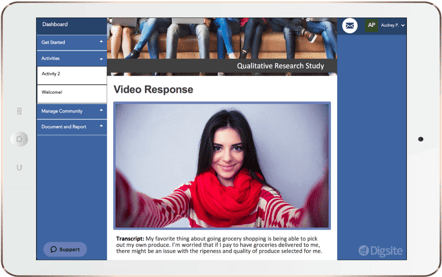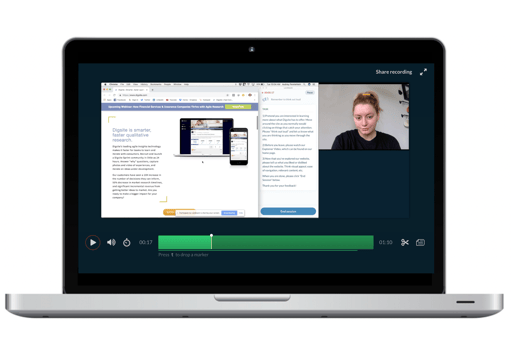Video technology has transformed the way companies learn from consumers. If you haven’t gotten your team hooked on a regular cadence of video insights, there’s no better time than now to get started. In this blog, we’ll cover how the latest video technology is being used and provide some concrete examples of the results companies have achieved.
These days, video insights are easier to collect than ever before. At the same time, consumers are creating and watching more and more video content every day. If you’re like most people, you might even record a video or two of your own throughout the week.
As we collectively get more comfortable with video, tools like Digsite have emerged that allow you to collect video responses, engage in live video interviews, and have participants record their screens or offline experiences.
Better yet, tools like Digsite allow research participants can do all of these types of video responses in a single study.
But the benefits of video don’t stop there. The best part about video insights is that today’s technology allows video to be accurately transcribed, analyzed, and built into shareable clip reels—in a process that takes minutes, not hours or days like it used to.
Add it all up, and building innovation plans that embed video insights directly into the process can increase the visibility and impact of your research, cut the time and cost of conducting research in half, and increase engagement across your team.
Agile Video: More Accurate Results Than In-Person Research
You might be thinking that this sounds like an audacious claim. But agile video research delivers more detailed and accurate insights than you can uncover during in-person sessions. That’s because agile video gives you ways to collect both attitudes and behavior in context, and combined with sprint communities like Digsite – the ability to follow-up and iterate as you learn.
The old way of video recording during in-person research meant you were confined to a fewer geographic locations. With online video research, you can talk to participants all around the country—or even the world. One of our customers recently witnessed the transformative nature of being able to reach a wider cross-section of participants online—and they haven’t looked back since!
With video, you can easily ask follow-up questions, and embed different tasks or activities into the research process to uncover deeper insights. For example, you might insert a video component in the middle of a sequence of other questions so you can create structured data (e.g., rate this product on a scale of 1 to 10) and unstructured data (e.g., record a video where you explain why you rated the product that way).
Video also lends itself to unmoderated testing. For example, you can ask participants to test out a new product or view a new website and “hear what they are thinking” with biasing them by standing over their shoulder.
What’s more, you can also use video collaboratively. For example, you can ask research participants to share their video stories—and then have each of them watch everyone else’s videos and respond.
This allows you to create a discussion where no one person is dominating the conversation. Instead, everyone has a chance to speak their mind—and then a chance to respond to what others have said.
Agile Video Saves Time and Money, Making Market Research More Feasible
In the old days, insights teams would have to travel somewhere and absorb the associated costs in order to conduct research. In the age of online video research, that’s no longer the case.
When teams move their research online, they have more flexibility. For starters, you can either conduct one-on-one interviews or group videos. Video interviews can also be live or they could be asynchronous (e.g., the participants film at their own leisure). Your team can watch videos in real time in a room together or they can watch them later.

Then there are advanced tools like Digsite that give you both video and text-based options. You can ask research participants to rate and rank ideas online and then have them create video responses to provide additional context and help you uncover the why. You can follow-up and iterate as you learn, taking the most important insights and bringing them to life.
Beyond that, online video also makes it much easier to recruit research participants, often in 24-48 hours. In large part, this is due to automated scheduling, text reminder notifications. And platforms like Digsite have instant-recruiting capabilities built right into the platform.
Once the research is complete, it’s much easier for teams to analyze the results. For example, automatic transcriptions are becoming increasingly accurate, and more sophisticated solutions combine that with human checks. Believe it not, transcripts for shorter videos can be put together in as little as an hour and longer videos in under 24 hours.
Further, today’s tools use natural language processing and sentiment scoring to automatically categorize video clips based on keywords and phrases—which makes it easier for teams to identify and quantify themes without having to re-watch every single second of video that was recorded. In fact, if they just want to see the clips where the participant mentioned a topic or keyword in a positive way, they can search for those clips instantaneously.
Leading video research tools also give insights teams the ability to create clip reels simply by highlighting text—which enables you to get a story reel faster than you can write a report.
3 Use Cases for Agile Video Research
Now that you’re aware of why agile research is effective and why more and more organizations are utilizing it, let’s take a look at how, specifically, companies are putting agile video to use.
1. An insurance company improves the customer experience
Nobody really gets excited about things like billing and enrollment. But an insurance company know it is critical to optimize the experience for its customers, so they turned to Digsite.
The company started by conducting live video interviews on a shared screen. They went through a form step-by-step to see whether customers found it easy to understand. The researchers were able to see if the customers were confused while going through a complicated document.
Next, they let customers mark-up specific features and react to potential changes. After that exercise, they jumped back into another round of video interviews to make sure they got everything down pat.
As a result of these activities, the insurance company was able to improve its forms considerably—all in the time and cost it would take to complete just one round of traditional in-person interviews.
2. Improving a chatbot
One of our clients wanted to roll out a chatbot on their website that would serve as a live customer service option. In an effort to improve the customer experience, the company wanted to do everything it could to strengthen its chatbot before it went live.
They turned to Digsite to gauge the chatbot experience by using a screen capture test that took place at the participants’ own leisure. When the customer interacted with the chatbot, researchers could see what their reactions were and see the screen. Participants were instructed to speak out loud during the test—saying what they liked and didn’t like about the experience.
They were also able to ask follow-up questions and probe into various features and options they were considering. Thanks to these efforts, the company was able to refine its chatbot in a few days, keeping on schedule to get it rolled out to all of their customers.
3. Strengthening a product line
Johnsonville is a major manufacturer of sausages. The Wisconsin-based company was rolling out a new line of sausage products and they wanted to make sure they were well-received.
Using Digsite, they asked research participants to take a photo of how the product was stored in their refrigerator. They also asked a subset of quantitative participants to capture product preparation and usage actions via video. Finally, they had these research participants complete fill-in-the-blank exercises to deliver into the unarticulated emotions they were experiencing.
As a result of these efforts, the Johnsonville team found out that one of the new sausage products didn’t fit in with the line. So they went back to the drawing board and created a new flavor that made more sense.
They also found that some of their customers were preparing the products in an uncommon way. Based on that information, they enhanced their instructions to improve the experience.
“Johnsonville is now officially hooked on Digsite and will be using the platform lots more on similar projects in the future,” explains Karen Kraft, senior consumer insights manager at Johnsonville.
Agile Video Research: Increasing Alignment and Accelerating Innovation
Agile video approaches enable teams to rapidly and cost-effectively test and build ideas—and retest them based on their learning. It also helps build stories and buy in throughout the organization.
Lots of communication is nonverbal, and video helps convey those nonverbal cues and reassure non-participants that they understand the results. So, in addition to finding out why folks feel the way they do, online video research also enables insights teams to stay on the same page and get better internal buy-in.
However, don’t look at agile as something that you may end up doing occasionally. For the best results, bake agile into the DNA of the research you conduct on a weekly or monthly basis.
Thanks to agile, you can enhance your research skills with modern video technology. This enables you to be a hero in the speed, cost, and quality of the research you conduct—which, over time, translates into much better business outcomes.
To learn more about how agile research can help your organization get results, download our eBook to find out how agile qualitative research is creating new opportunities for organizations.





